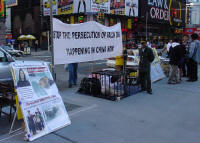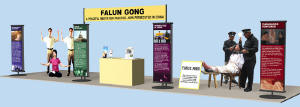(Clearwisdom.net) In the past two months, the torture exhibits have had a huge impact in Manhattan. They are very effective at drawing people's attention, and most everyday people in New York that we have talked to have seen our exhibits many times and in different parts of the city.
Unfortunately, many people still don't have a clear understanding of who we are and what our exhibits are about. One typical example was a man one of us talked to at a business conference two weeks ago. After I mentioned Falun Gong, he said, "Oh yeah, I've seen the exhibits all over the city." But then his first two questions were, "So what are those exhibits all about?" and "What is Falun Gong?" That is to say, he still didn't really know anything about Falun Gong or the persecution.
Furthermore, many people often have misunderstandings about who we are, what the persecution in China is and why we are having the exhibits. For example, some people have asked us, "Who is this Falun Gong person? Is that the doctor who is in prison in China?" Some think that Falun Dafa uses torture methods as a part of its practice in order to show how much practitioners can endure. Others have told us that they thought we were trying to raise money.
Of course, once these people speak with a practitioner or carefully read through our materials, their confusion is quickly cleared up. However, we don't know how many people walk by with these notions, yet fail to stop to talk to us.
Thus, while our exhibits have had a tremendous effect and countless New Yorkers have become more clear about Falun Gong after talking with our practitioners, our understanding is that we need to improve the presentation of and message communicated at our torture exhibits so that those who pass by or just stop to read for a moment before moving on can easily gain an understanding of Dafa and the persecution. Additionally, perhaps if we can improve our presentation and message, our exhibits will be more inviting for people to approach us and talk to us.
Our presentation is also validating the Fa
In the March 1999 lecture in New York, Master answered a question from a practitioner about behavior:
Teacher: Speaking of this, I have some of my own thoughts. Let me tell you, prior to the Cultural Revolution, Chinese people were known as a cultured people that were very particular about being civilized, about hygiene, and about formalities. Chinese people brought civility to neighboring countries--they learned from China. (Applause) But did you know that after the Cultural Revolution, these were discarded as "the four olds"? Instead, people were encouraged to have dirt all over their bodies with thick calluses on their hands. Even lice were called "revolutionary bugs." People regarded filth as something good. This kind of concept continued into the future. Right now, even though people's living conditions have improved, and they're now more attentive to things, the concept left over by the Cultural Revolution has yet to be discarded. Therefore, after you arrive in Western societies, people here feel it's hard to tolerate you in that regard.
You don't mind the details, don't groom yourselves, and look sloppy. You talk loudly, without taking the circumstances or location into consideration. You don't pay attention to hygiene. Of course, I've said that you have to conform to everyday people to the maximal extent for your cultivation. As disciples who are practicing cultivation, you must be able to achieve that. This originally was a non-issue, and was not what I wanted to discuss. But did you know that because of your behavior, some Western students have been afraid of joining you for Fa-spreading activities? Everyone must pay attention to this! This is not just a behavioral issue. You really should pay attention to things in this regard. I'm not saying that you need to be particular about dressing stylish. You should understand human civility on the very surface. I can tell you, Dafa actually also encompasses the substances from the lowest level. If you can think of others in everything you do, I think you'll do everything well. (Applause)
To our understanding, Master mentioned a related principle when commenting on a disciple's article on Clearwisdom: "If all Chinese Dafa students can be more mindful of their conduct in daily life, be neater, and be considerate of others in everything they do, then that's the demeanor of Dafa disciples."
We think that this Fa is very applicable to how we present ourselves and our information at the torture exhibit sites. Some torture exhibit sites are very messy, with posters scattered all over the ground, practitioners sitting on the ground, not dressing neatly, the posters are very dirty and taped together in a messy way, etc.
When people walk by, they could easily feel offended or even look at us much like they look at homeless people who often carry around all of their dirty belongings in the street.
We found it interesting that the sites organized by Singapore and Hong Kong practitioners seemed, in general, to be the most organized, with very clean and neat presentations. Perhaps the additional pressure put on practitioners from the Singapore and Hong Kong governments have made them pay extra attention to the minor details. However, this "pressure" is the old forces arrangements and we as Dafa disciples should not need this to "temper" ourselves in this regard. All Dafa disciples, no matter where they are from, should be able to present themselves with dignity and in a suitable manner.
Above: Hong Kong practitioners display posters about Falun Gong next to practitioners practicing (left), and on the other side of a table holding materials they display the torture exhibit with posters about the persecution (right)
Lastly, even though some of the images we display are graphic, we still need to do so with dignity and without human notions. There are many radical groups in the U.S. that protest, and they purposely adopt shocking methods to grab people's attention. For example, some anti-abortion activists take gory photos of aborted fetuses, put them on posters and show them all over the place in order to shock people, and this often has a very negative effect. When we display our images, we should maintain our pure hearts and dignified nature, and be careful not to adopt any everyday people's notions about trying to shock people.
Keep the message clear and simple
Western minds are fairly simple. Once they ask "why?" and you tell them, they generally don't continue asking "why of the why?" Therefore, a simple and clear message is enough.
Currently, at many of our torture exhibits, there are many, many banners that raise more than 10 different points about what the persecution is, how it started, the role of propaganda, self-immolation, business investments, mental hospitals, etc. For everyday people, however, all these different messages can easily be confusing and sometimes overwhelming. Many of the everyday people passing by our exhibits don't even know what Falun Gong is...a person? A martial art? A political party? With so many different points and messages facing those who walk up to our exhibits, it can easily be too much and cause people to turn away since they don't know where to begin.
At one torture exhibit, the largest and most visible sign was about the self-immolation, declaring, "Self-immolation is a hoax," with pictures of the self-immolators and other evidence. For those passing by, the entire exhibit could easily be misunderstood as "something about people who burned themselves." Another banner we saw showed boiling liquid being poured into a caldron in an attempt to communicate the "poison" of the propaganda, but again, to someone just passing by who knows nothing about the context or background for this issue, it makes no sense.
Therefore, our message should be grounded in the basics: "Falun Gong is a peaceful meditation practice that is now being violently persecuted in China."
Master did tell us to clarify the truth in a more in-depth manner. Our understanding, however, is that this doesn't mean that we need more banners and poster boards at our displays. The banners and posters are there to give people an understanding of what our exhibit is about and a little background on Falun Gong and the persecution...true in-depth truth-clarification will come from talking with one of our practitioners or taking one of our truth-clarification materials and reading through it.
There is a Chinese saying: "False teachings from 10,000 scrolls, one true teaching from one sentence." And, of course, Master has told us: "The great way is simple and straight forward."
We should be able to adopt this principle in the presentation of our banners at the torture exhibits.
Make it clear that Falun Gong and the persecution are two different things
One specific issue that many of the sites have realized is that people are very confused when we mix information about the practice of Falun Gong together with information about the persecution. People sometimes don't know if Falun Gong is a regime that is persecuting people, or even if enduring persecution is part of the practice.
Thus, we recommend keeping these two topics physically separate in the torture exhibits. As an example, practitioners in New York have developed a torture exhibit design that we will be using at a few sites throughout Manhattan...
Adapt to the situation
We think that the principles behind the above suggestions are more important than the suggestions themselves because for any given situation we may need to adapt differently. For example, the torture exhibit sites that are on very busy streets where people walk by very quickly should probably make an extra effort to ensure that the message on the banners is very simple and straight forward, so that people walking by can understand something clearly with a glance. For the torture exhibit sites that are in parks or other more relaxed environments, however, you may notice that people stop and read every banner. In this case, we might want to display more banners and pay more attention to laying them out so that as people go from banner to banner while reading, together they tell a coherent story.
The above are some understandings of New York practitioners. Please point out anything that is not correct and supplement what is incomplete. Thank you.
Category: Journeys of Cultivation









